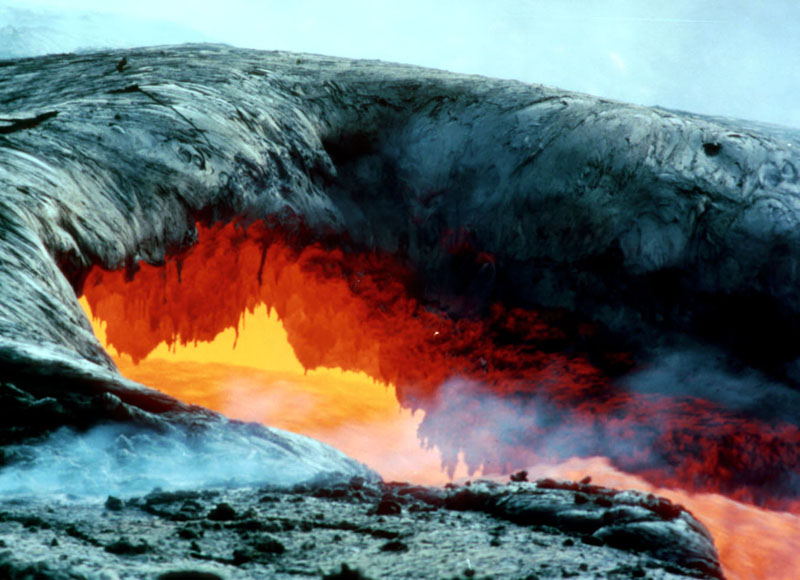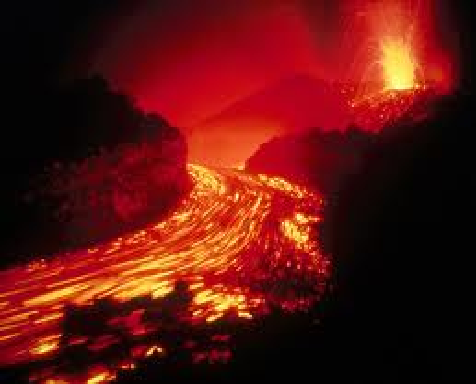
THE VOLCANO OF MAUNA LOA.
IN the middle of the Pacific Ocean, is a group of islands known as— the Sandwich, or Hawaiian, Islands. No doubt nearly all of the readers...have learned about them in their geography lessons at school; but perhaps you never knew anything particularly interesting about them, except that the natives were mostly idolaters and cannibals until the missionaries went there and taught a better and happier way of living. There are twelve of these islands in all, but only eight of them are inhabited, and on these about 80,000 people live, in all. The capital, Honolulu, is situated on the island of Oahu; but Hawaii is by 'far the largest as well as the most interesting of the group. The central part of Hawaii forms an elevated plateau from 3,000 to 4,000 feet high, which is almost entirely covered by thick forests, roamed over by herds of wild cattle. Above the plateau rise four volcanic peaks, the loftiest being nearly 14,000 feet high. At some time these have all been active volcanoes, but Mauna Loa, rising over 13,000 feet, is the only one, which still remains so.
This is one of the most wonderful volcanoes in the world, and has a number of craters from which the burning lava pours forth in the time of an eruption. The central one is about 8,000 feet in diameter, and the walls rise perpendicularly from 600 to 800 feet. The bottom, or floor, of this pit is covered with hardened lava when the volcano is quiet. -Through the cracks, or fissures, of this floor constantly issue steam and sulphurous vapor; and at intervals are chimney-like openings called cones, from the top of which, every few minutes, the burning, seething lava bursts up and rises in a fiery column, sometimes to the height of several hundred feet. The picture will give you some idea of bow it all looks, only you must imagine the columns of lava red as fire.
People like to stand on the brink of this crater and look down into the pit and watch the play of these fiery jets, and some travelers are bold enough to go down into the bed of the crater and walk about on the lava floor among the cones. Of course this is a dangerous thing to do, for no one knows at what moment an eruption may take place, throwing- the whole burning mass up to the top, and pouring it down the mountain-side in burning rivers of lava. Sometimes the volcano is quiet for years, and then with scarcely a warning it sends forth its fiery flood to deluge forests, fields, and villages.
About sixteen miles from this terminal crater of Mauna Loa (Moknaweowes) is another called Kilauea, which is said to be the largest active crater in the world. This crater basin is oval-shaped, and at one end is a lake of liquid fire, now foaming, surging, and leaping, like the waves of the ocean when stirred by some mighty storm; and "the roar is more terrible than loud sea-surfs beating against bold bluffs." Again, all is quiet, and the surface of the lake looks black and dismal; but in a few moments fiery jets begin to be thrown upward, and soon the whole is again a roaring, tumbling mass of liquid flame.
One of the most violent eruptions of Mauna Loa took place in the year 1868; and some description of that terrible destruction may give a better appreciation of the fearful power of a volcano than could any other words:—
"On March 27 of that year, a series of earth quakes began, and became more startling from day to day, until their succession was so rapid that the island quivered like the lid of a boiling pot nearly all the time between the heavier shocks.
The trembling was like that of a ship struck by a heavy wave. Then the terminal crater of Mauna Loa sent up columns of smoke, steam, and red light; and it was shortly seen that the southern slope of its dome had been rent, and that four separate rivers of molten stone were pouring out of as many rents, and were flowing down the mountain sides in diverging lines.
Suddenly the rivers were arrested, and the mountain dome appeared against the still, blue sky, without an indication of fire, steam, or smoke. The town of Hilo, near the coast, was much agitated by the sudden lull. No one was deceived into security, for it was certain that the strangely pent-up fires must make themselves felt.
"The earthquakes became nearly continuous, until scarcely an appreciable interval occurred between them. Late in the afternoon of a lovely day (April 2) the climax came. The crust of the earth rose and sank like the sea in a storm. Rocks were rent, mountains fell, buildings and their contents were shattered, trees swayed like reeds, animals were scared and ran about demented; men thought the Judgment day had come. The earth opened in thousands of places, the roads in Hilo cracked open, horses and their riders and people on foot were thrown violently to the ground; 'it seemed' said an eye-witness, `as if the rocky ribs of the mountains and the granite walls and pillars of the earth were breaking up.' In Kau, south of Hilo, they counted 300 shocks on this direful day; and the earth swayed to and fro, north and south, then east and west, then round and round, up_ and down, in every direction, while the trees thrashed as if torn by a strong rushing wind.
"An avalanche of red earth, at first supposed to be lava, burst from the mountain-side, throwing rocks high into the air, swallowing up houses, trees, men, and animals. It traveled three miles in as many minutes, burying a hamlet, with thirty-one inhabitants and 500 head of cattle!'
The people of the, valleys fled to the mountains, which themselves were splitting in all directions, and collecting on an elevated spot, with the earth reeling under them, they spent the night of April 2 in prayer and singing. Looking towards the shore, they saw it sink, and at the same moment a wave, whose height was estimated at from forty to sixty feet, hurled itself upon the coast, and receded five times, destroying whole villages and even strong stone houses with a touch, and engulfing forever forty-six people who had lingered too near the shore.
"Still the earthquakes continued, and still the volcano gave no sign. The nerves of many people gave way in these fearful days. Some tried to get away to Honolulu, others kept horses saddled on which to fly, they knew not whither.
The hourly question was, What of the volcano?
People put their ears to the quivering ground, and heard, or thought they heard, the surgings of the imprisoned lava sea rending its way among the ribs of the earth.
"Five days after the first outburst of April 2, the ground south of Hilo opened with a crash and roar, which at once answered all questions concerning the volcano. The molten river, after traveling underground for twenty miles, had emerged through a fissure two miles in length with tremendous force and volume. It was in a pleasant pastoral region, supposed to be at rest forever, at the top of a grass-covered plateau sprinkled with native and foreign houses, and rich in herds of cattle. Four huge fountains boiled up with terrible fury, throwing crimson lava and rocks weighing many tons to a height of from 500 to 1,000 feet. From these great fountains to the sea flowed a rapid stream of red lava, rolling, rushing, and tumbling, like a swollen river, bearing along in its current large rocks that made the lava foam as it dashed down the precipice and through the valley into the sea. It was nothing else than a river of fire from 200 to 800 feet wide and twenty feet deep, with a speed varying from ten to twenty-five miles an hour!' "
In some of these eruptions of Mauna Loa, such vast quantities of lava have found their way to the sea as to form huge promontories, and even fill up whole bays.
With such a mass of molten fire pent up in the bosom of the earth, how easily could the fires of the last day be kindled, when "the mountains shall quake at Him, and the hills melt, and the earth is burned at his presence, yea, the world and all that dwell therein."
E. R. G.
